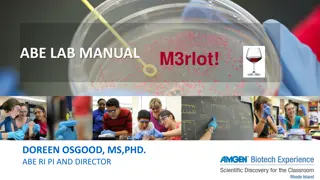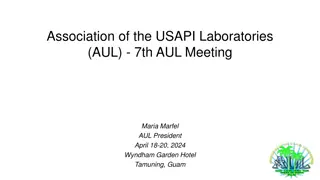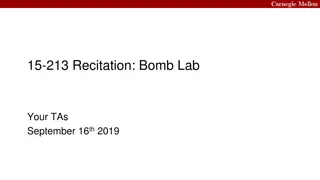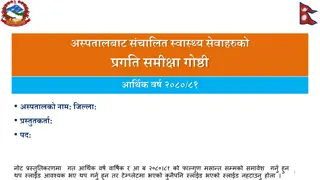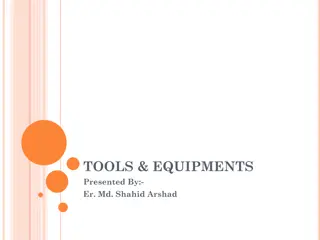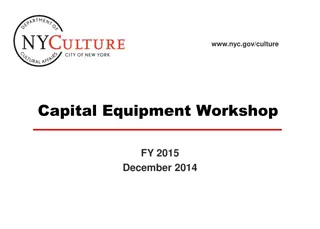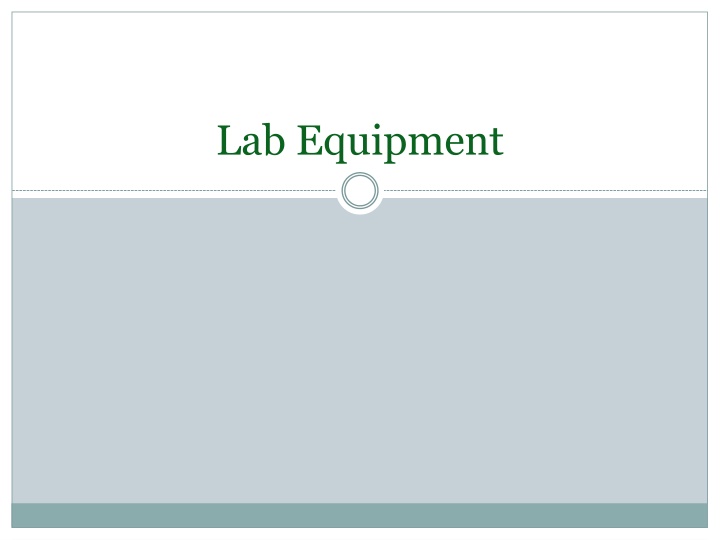
Essential Laboratory Equipment and Tools for Scientific Experiments
Explore the functions of various types of lab equipment such as Erlenmeyer flask for storing samples, test tube for mixing chemicals, hot plate for heating, dissecting tray for specimen handling, forceps for picking objects, apron for protection, cover slips for microscopy, dissecting pins for specimen fixation, dissecting scissors for dissections, and scalpel for surgical procedures. Enhance your understanding of lab practices with these essential tools.
Download Presentation

Please find below an Image/Link to download the presentation.
The content on the website is provided AS IS for your information and personal use only. It may not be sold, licensed, or shared on other websites without obtaining consent from the author. If you encounter any issues during the download, it is possible that the publisher has removed the file from their server.
You are allowed to download the files provided on this website for personal or commercial use, subject to the condition that they are used lawfully. All files are the property of their respective owners.
The content on the website is provided AS IS for your information and personal use only. It may not be sold, licensed, or shared on other websites without obtaining consent from the author.
E N D
Presentation Transcript
Bell Ringer List at least 3 types of lab equipment and explain the function of each.
Erlenmeyer Flask A flask that may be closed with a stopper in order to store samples. These flasks are also useful for mixing solutions for chemical reactions.
Test Tube Hold, mix or heat small quantities of liquid or solid chemicals for assays and qualitative experiments ANd9GcT-L9lkLs56gTbx1zNTfAiWov7e8DqqmtvJEE6dFGlu7Q3FvV3ZsejXDUI
Hot Plate generally used to heat glassware or its contents ANd9GcT7phPl1N4Cq3y9CxM-d3Zy4TSpB2AjqoGRiGX9KvNrPOq2Cudymf192vI
Dissecting Tray Metal pan filled with tar or paraffin used to hold down specimen with pin. ANd9GcS3plTWQfu0-XCdRDwxaH0x4xIDDn2UiP3rAFXdwy_7tw18yBPhuGjOB5s
Forceps Used to hold or pick up small objects ANd9GcSJKq6UrfJMpuOvHK29dZKaabDVdtxUwfPslbazqhJn4r6xouTm40va630
Apron Protects clothing and possibly skin ANd9GcR9_3UevB4QbOMg59cWvzFjwvowU-HUOaFOJxsZ7VxGMzLT2LIj46zyVGI
Cover slips Placed over objects that are resting on a slide for viewing with a microscope. ANd9GcQAjRP-nQmEuzRIgzvP0RcNXvakjCHuVj1hYUhrD7TAUrijEbXdxFp03bs
Dissecting Pins hold the specimen in place during dissection. ANd9GcS0x1PZyk126fk-_hUF-ETMX3xEEUx4UAX6LHSAVeGdOE7qHbw9k4xrODTW
Dissecting Scissors Scissors that is used in a classroom setting for dissections or in medical and surgical settings. ANd9GcQfA80g59aUiv-NKg2pE1yacMpNh2jfh-vWFqC7f_-twmCRZG91jFrqWw
Scalpel small and extremely sharp bladed instrument used for surgery, anatomical dissection ANd9GcScD4-VjxV4kMuZY-Gr1PHlFDiJgfBemRMmpvF84MehLJiWAqwwv_yRTA
Probe Tool can facilitate the dissection by helping to pin body parts or explore the exposed structure of the object being dissected ANd9GcRHzpERVhJ549OOOfNgS97pGGXrMRtaJ83sP8Aokp5HQ6ts6ztYuZmv4kA
Microscope Slide Used to hold objects for examination under a microscope
Metric Ruler Measuring instrument. Always use the metric side of a rules in science. ANd9GcRCvolS-0dU64dL7FJjyyDUNPzpDPJ7yH5Zx1PYhP3JZGFiC9aQQcH3wA
Goggles Protect eyes from chemicals and other hazards that exist in a lab setting. ANd9GcSILQ83kbBBrhswqQk8wPum9vdQV3ChPTxaBsHIxIlcdNYkW6AU9_rH7A
Triple Beam Balance Used to measure masses very precisely ANd9GcQhXzN37YqtU7VG6jtim_BrPfYlrZR_6C4YRDKrx66_t0tvWdjs5a9gmoF0
Graduated Cylinder Used for measuring volumes (amounts) of liquids. When using this, it is important to read the bottom of the meniscus ANd9GcRybhisOGURrw7-faoNHpllpuc1wIGUyk6g9xM9t5CvdIMbMD1VkYjwwEY
Beaker Simple container for stirring, mixing and heating liquids ANd9GcQ975NIBIQaBdNprID-2AjjTOk5__QU3fN6Qxoy2QLOgDCbaJeOihj5rOw
Compound Microscope Used to observe or analyze microscopic objects. Can only view samples that light can pass through. ANd9GcQ_npyVZ4EGBmaDDBAgXCx63ddXCgG7Yxv6wpCBoLDvlhqnqPIHIxELoRw
Test Tube Rack Hold and transport test tubes during experiments or while examining cultures. They can also accommodate other lab tools ANd9GcTJeTWwP4llNaCzWcd8CUR05UuIEyZph0vwV_HsUvDNlHBArDghUbj2DKXtJA
Pipette Used to transfer small amounts of liquids. The pipette pictured is less accurate though some may have volume marking for 1ml or 2ml. ANd9GcTYTnUIYpuK0cmMBJW08EpkeaeT1YzQkfuDiJJu94IATQzYtI7nQvmgvQ
Micropipette Accurately transfer small volumes of liquids in a laboratory. Pressing on a plunger button at the top of the micropipette will pull the liquid in, and a second press will dispense it. ANd9GcSuZV_KwU7MwPvBx2rLh3MXd6mwf9-cgUsheSImwSDYqN9he16Z5CrsAALM
Thermometer Measures temperature. ANd9GcTIQ6FwKCebJywv9opN2Qb9oYODoDV-KOCHbzTI-kIy2SCiL_eQuSNtpqxp
Funnel Used to channel liquid or fine-grained substances into containers with a small opening. ANd9GcQSHyB9EFfK_5mpIsD7uv2Eq1P2PrQlbytlvfIYlsoKa_64gWjd6ppTvg
Petri Dish Used to culture cells or observe some small organisms. ANd9GcRwjqVWMHRjheUSL3oOJjRBsNghpK_e-VNnthzGmofYdk0uRPPTh4Y0T-1bJw
Tools The equipment used in the lab are simply tools. Sometimes equipment can be used effectively in a way that it was not designed for. If it works best for what you are doing then use it!
Analysis Make sure you have complete the analysis questions.

